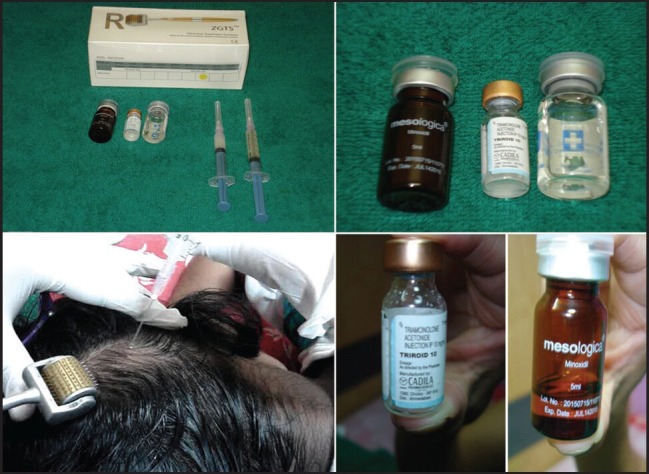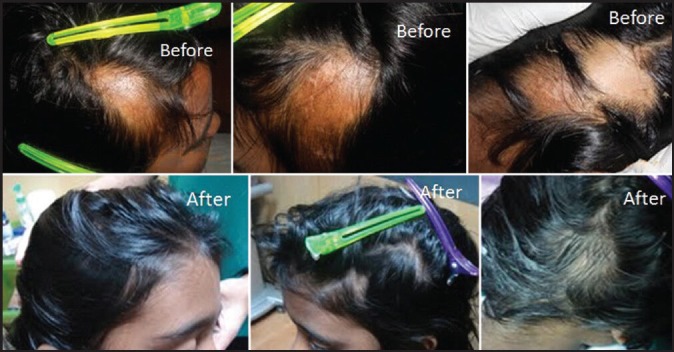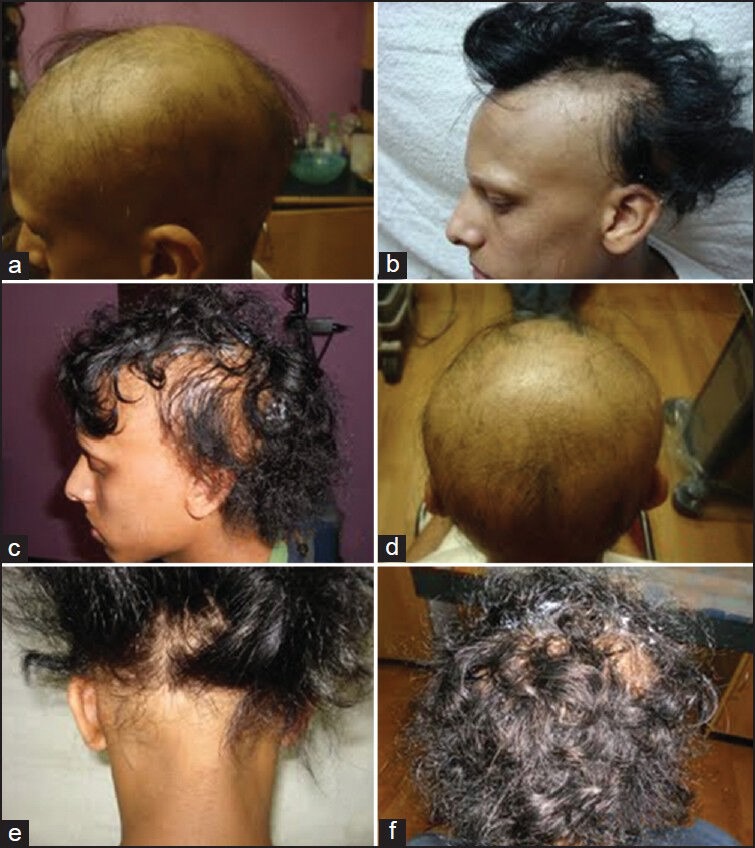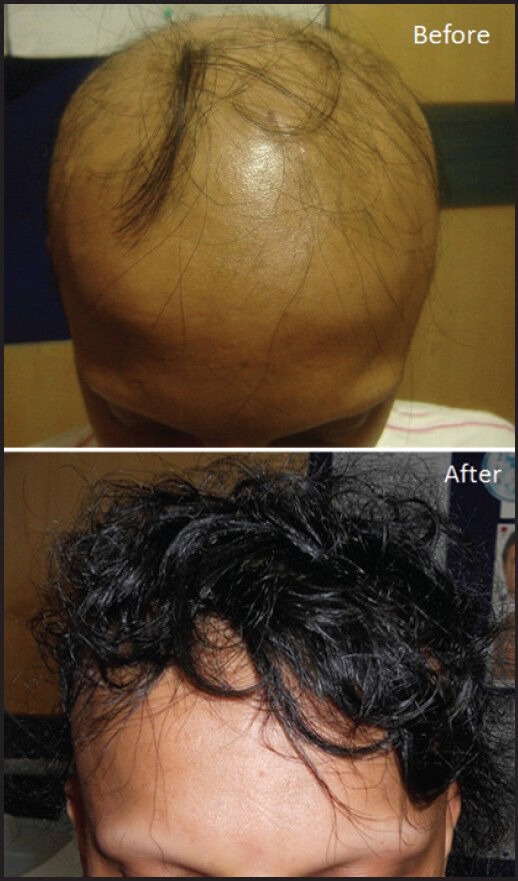Sir,
Many therapeutic modalities have been used to treat alopecia areata (AA), with variable efficacy and safety profiles. Multiple patches, alopecia totalis/universalis have poor prognosis. A number of treatments can induce hair re-growth in AA but none can change the course of the disease. We report three cases of AA treated with Scalp Roller therapy, which were resistance to both systemic and topical treatment for inducing hair on cosmetic region like scalp.
Case 1: An 11-year-old girl presented with three well defined smooth patches of hair loss of over occipital area of 7 × 5 cm and right and left parietotemporal area (6 × 4 cm) for 2 years. Two patches over parietotemporal area showed speckled areas of depigmentation and superficial scarring due to intra-lesional steroid injections.
Case 2: A 34-year-old male presented with loss of hair over scalp (ophiasis pattern), eyebrows, beard area and axilla and loss of eyelashes since 4 years suggestive of alopecia universalis.
Case 3: An 18-year-old male presented with features of alopecia universalis for 2 years. Biopsy of case 1 was done and it showed features of AA. All the three cases were previously treated with contact sensitisers, topical tacrolimus, minoxidil and corticosteroids and oral mini pulse betamethasone. Case 1 was treated with intralesional steroids as well. There was some response noticed for few months and again there was relapse in all the three cases.
We treated all the three cases as below:
Under aseptic precautions scalproller (1.0 mm) was rolled with gentle pressure to create microchannels. In a syringe a mixture of 1 ml of triamcinolone acetnoide (10 mg/ml), 0.5 ml of meso-solution (growth factors, copper tripeptide-1, multivitamins, aminoacids and minerals) and 0.5 ml of injectable minoxidil 2-5%(mesolgia) was taken and sprayed over the scalp [Figure 1]. Case 1 showed more than 90% improvement after four sessions [Figure 2]. Case 2 showed 50% improvement of scalp hair after five sessions. Case 3 showed 75% improvement in six sessions [Figures 3 and 4]. There were no adverse events noticed and improvement was not seen in eyebrows, axilla hair, etc., even though they were on systemic therapy. Hence Scalp Roller therapy might have helped in treating AA locally.
Figure 1.

Photograph showing the scalproller procedure and the solutions used
Figure 2.

Before and after photographs of right and left parieto-temporal patches and occipital patch after four sessions of scalp roller therapy
Figure 3.

(a, b and c) shows patient with alopecia universalis (lateral profile) at session 1, after 4 sessions and 6 sessions; (d, e and f) shows occipital area at session 1, after four sessions and six sessions
Figure 4.

Before and after photograph after six sessions of scalp roller (frontal view). Note that there is no improvement in eyebrows, which was not treated
We used “Scalp Roller Therapy” because
Intralesional corticosteroids are widely used in the treatment of AA and is the first-line treatment in localised conditions involving < 50% of the scalp.[1] When AA involves > 50% scalp area or multiple patches involved, intralesional injections would be painful and difficult to cover entire scalp. To reduce the adverse effects of triamcinolone acetonide (TAC) like atrophy/depigmentation.
TAC (10 mg/ml) diluted with mesosolution+ injectable minoxidil (2-5%) instead of normal saline as few pilot studies have shown that cocktail solutions restore and increase local microcirculation, provide nutritional input, stimulate the hair's environment through needling and complement other treatments.[2] Contents of cocktail changes due to the physician's practise and experience.[3]
It allows a painless skin perforation and provides uniform delivery of therapeutic molecules into the scalp by creating microchannels.[4] A pilot study by Dhurat et al., showed that microneedling with 5% minoxidil showed better response than only topical minoxidil in androgenetic alopecia.[5]
Scalproller breaks down the dermal capillaries and platelets begin to form a plug at the site of the damage to temporarily stem bleeding and release the chemotactic factors/growth factors. This suggests that Scalp Roller alone helps in stimulation of hair growth. Hence we advised our patients to do Scalp Roller therapy at weekly intervals.
We report three cases of resistant AA treated by multimodal approach where Scalp Roller therapy was found to be useful and safe in treating multiple patches/alopecia totalis. However, it cannot be ascertained strongly as to which modality worked, which needs randomised controlled studies to prove the efficacy. Hence we suggest that Scalp Roller therapy can be used as an effective adjunct to the conventional therapy to treat resistant AA cases locally.
REFERENCES
- 1.Ross EK, Shapiro J. Management of hair loss. Dermatol Clin. 2005;23:227–43. doi: 10.1016/j.det.2004.09.008. [DOI] [PubMed] [Google Scholar]
- 2.Omer F. The treatment of hair loss in mesotherapy. In: Madhere S, editor. Aesthetic Mesotherapy and Injection Lipolysis in Clinical Practice. 2nd ed. New York: Informa Healthcare; 2007. pp. 109–43. [Google Scholar]
- 3.Jäger C, Brenner C, Habicht J, Wallich R. Bioactive reagents used in mesotherapy for skin rejuvenation in vivo induce diverse physiological processes in human skin fibroblasts in vitro- a pilot study. Exp Dermatol. 2012;21:72–5. doi: 10.1111/j.1600-0625.2011.01400.x. [DOI] [PubMed] [Google Scholar]
- 4.Prausnitz MR. Microneedles for transdermal drug delivery. Adv Drug Deliv Rev. 2004;56:581–7. doi: 10.1016/j.addr.2003.10.023. [DOI] [PubMed] [Google Scholar]
- 5.Dhurat R, Sukesh M, Avhad G, Dandale A, Pal A, Pund P. A randomized evaluator blinded study of effect of microneedling in androgenetic alopecia. A pilot study Int J Trichology. 2013;5:6–11. doi: 10.4103/0974-7753.114700. [DOI] [PMC free article] [PubMed] [Google Scholar]


